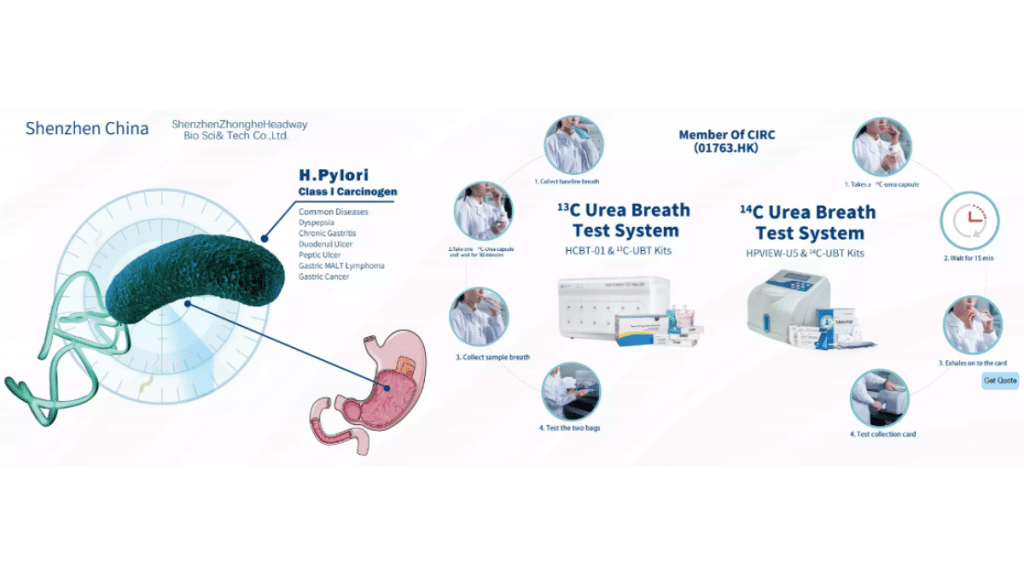Helicobacter pylori (H. pylori) infection is unfortunately very common. It is closely associated with many digestive diseases. Some examples include chronic gastritis and peptic ulcers. It even increases the risk of stomach cancer. The Urea Breath Test procedure is valuable as it effectively detects this infection. Its popularity stems from its reliability, non-invasive nature, and quick results.
Understanding H. pylori Infection
Helicobacter pylori is a bacterium that lives in the stomach and survives in gastric acid. About half the world’s population carries this bacterium.
Many people with H. pylori show common symptoms. These vary in intensity. However, some people have no symptoms at all.
The typical infection symptoms include:
- Abdominal pain
- Bloating
- Nausea
- Vomiting
- Frequent burping
- Loss of appetite
- Weight loss
- Bad breath
Untreated H. pylori infection leads to serious health problems. It causes peptic ulcers. These ulcers can bleed and might perforate the stomach wall. Long-term infection raises stomach cancer risk. It links to MALT lymphoma. Proper diagnosis via the Urea Breath Test procedure helps identify causes of H. pylori and prevent these complications.
The Basic Principle of the Urea Breath Test
The Urea Breath Test procedure works on a simple principle. The infection produces urease. It breaks down urea, creating ammonia and carbon dioxide. Patients swallow labeled urea during the test. H. pylori breaks down this urea if present, creating labeled carbon dioxide. The CO2 enters the bloodstream and is exhaled through the lungs. The test measures this labeled CO2. Higher levels show active infection.
Urea Breath Test Procedure: 13C and 14C
Two main types of Urea Breath Tests exist today. Both use different carbon isotopes. Both procedures are simple and can be finished within an hour.
(1) 13C Urea Breath Test Procedure
The 13C Urea Breath Test for H. pylori uses a non-radioactive isotope. It’s safe for everyone, including pregnant women and children. It has an accuracy of up to 95% and is used worldwide. Here are the steps of this Urea Breath Test procedure:
- Collect 0-Minute Breath: Fast for two hours. Blow into the collection bag and seal it properly. This creates your baseline.
- Take the 13C Urea Capsule: Swallow one capsule with water. Wait 30 minutes.
- Collect 30-Minute Breath: Blow into another bag and seal it carefully. This is your post-urea sample.
- Testing: A detector analyzes both samples. The 13CO2 difference shows infection status. A result ≥ 4.0 means positive.
(2) 14C Urea Breath Test Procedure
The 14C Urea Breath Test uses a radioactive isotope. The radiation level stays very low. The test gives quick results and allows infection level measurement. This Urea Breath Test procedure is straightforward. Here are the steps:
- Take a Capsule: Fast for two hours. Then take one 14C urea capsule with water.
- Collect Exhaled Air: Wait 15 minutes. Use the collection card. Blow until the indicator changes color. This takes 1-3 minutes.
- Detection: Insert the card into the analyzer. The results are typically available within 30 minutes to 1 hour.
Post-test Considerations
Several factors need attention after the pylori breath test. Follow these guidelines for the best outcomes:
- Wait for the results as instructed. Some come immediately, while others take longer.
- Continue fasting until fully done. Early eating affects results.
- Resume medications after completion. Some need an immediate restart.
- Discuss the results with your doctor.
- Follow-up testing confirms treatment success. This happens 4-6 weeks after therapy.
Advantages of the Urea Breath Test
The Urea Breath Test for H. pylori offers many benefits. These include:
1. Non-invasive
The test involves no invasive procedures. No endoscopy is needed, and no biopsy is taken. Patients just swallow a capsule and provide breath samples. No pain occurs, and no discomfort exists.
2. High Accuracy
Both Urea Breath Test procedure types offer excellent accuracy. They detect active infections and demonstrate 95% specificity. This beats many other tests.
3. Convenient and Fast
The entire test takes under an hour. Results often come same-day. The process is straightforward and works in outpatient settings. You can resume normal activities immediately after.
4. Wide Applicability
The Urea Breath Test procedure suits most patient groups. It works for initial diagnosis and confirms treatment success. The 13C Urea Breath Test is safe for pregnant women and suitable for children.
Appropriate Population for the Urea Breath Test
The Urea Breath Test (UBT) suits many patients. Some groups benefit more, while others need caution.
(1) Recommended Population
The test is ideal for suspected H. pylori cases. This includes dyspepsia patients. It helps those with peptic ulcers and benefits gastritis sufferers. It suits those preferring non-invasive methods.
(2) Cautious Population
Some patients need test cautions. Those taking acid reducers should pause medication. This means stopping 2 weeks before testing. Antibiotic users should wait 4 weeks. The 14C Urea Breath Test isn’t for pregnant women. It’s also not for young children. Uremia patients need doctor consultation first.
Frequently Asked Questions About UBT
Many patients ask about this test. Understanding common concerns helps in the preparation for Urea Breath Test. These answers address frequent questions:
Q: Does UBT Have Radiation Risks?
The 13C Urea Breath Test uses no radioactive material. It poses zero radiation risk. The 14C test uses a radioactive isotope. Its exposure remains minimal, about 1 μCi. This falls below daily background radiation.
Q: What Preparations Are Needed Before the Urea Breath Test?
Proper preparation ensures accuracy. Fast for two hours minimum. Stop acid reducers 2 weeks before. Avoid antibiotics for 4 weeks prior. Don’t take bismuth for 2 weeks. Inform your doctor about all your medications.
Q: What Are the Differences Between 13C and 14C Urea Breath Tests?
They differ in isotope type. The 13C test uses non-radioactive carbon and is suitable for all patient groups, while the 14C test uses radioactive carbon and has certain population restrictions. The 13C needs two breath samples, whereas the 14C test typically needs only one. Both tests show similar accuracy rates.
Q: Do Children Need to Adjust the Testing Process?
Children can undergo the 13C Urea Breath Test safely. Doses are adjusted based on weight. Young children may use masks. Young children may use masks for breath collection, and collection times may be shortened. Clear instructions are essential, so parents should remain present during testing.
Headway Offers Reliable H. pylori Urea Breath Test Kits and Analyzers

Founded in 1996, Headway has over 20 years of innovative experience in global Helicobacter pylori diagnostic solutions. Their UBT kits and analyzers have served over 20,000 healthcare institutions in more than 74 countries and regions. Their products primarily include capsule-based breath test kits and analyzers for 13C and 14C detection, as well as additional specific solutions.
- Three R&D centers drive innovation
- 7,000m² production area ensures quality
- Strict quality controls guarantee reliability
- Technical support trains healthcare staff
- Cost-effective solutions increase access
- User-friendly designs simplify testing
Visit Headway’s official website to explore its full range of diagnostic solutions. Your patients deserve quality healthcare technology. Non-invasive testing makes healthcare better.
